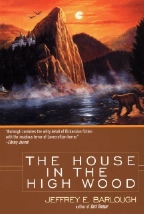The House in the High Wood
Jeffrey E. Barlough
Ace Fantasy
US Trade Paperback
ISBN 0-441-00841-0
318 pages; $14.95
Publication Date: 08-07-2001
Date Reviewed: 08-07-2001
Review Revised: 07-19-04
Review © Rick Kleffel 2002

REFERENCES
COLUMNS
|
|
|
The House in the High WoodJeffrey E. BarloughAce FantasyUS Trade PaperbackISBN 0-441-00841-0318 pages; $14.95Publication Date: 08-07-2001Date Reviewed: 08-07-2001Review Revised: 07-19-04Review © Rick Kleffel 2002 |
|
|
REFERENCES |
COLUMNS |
For the most part, it's actually good that "They don't make 'em like that anymore". The world has moved past the times of Edgar Allen Poe, Arthur Conan Doyle, Charles Dickens and H. P. Lovecraft. But that surely does not stop a trainload of writers from setting new novels in past times, though most of those novels are written with today's serial killer studies firmly entrenched in the foreground. In his first novel, 'Dark Sleeper', Jeffrey E. Barlough showed that he was not afraid to try something totally different. He gave us a novel with Victorian language and sensibilities, and set it in an imaginary wild west that never was, a wild west without guns, but with wooly mammoths, sabre-tooth tigers and subtle and terrifying supernatural entities. He returns to that world -- and writing style -- in his second novel, 'The House in the High Wood'. He slightly expands his territory, retains his Victorian writing manners, and in the end comes up with another unusual blend of enjoyable characters and a very chilling story of supernatural revenge.
Billed as 'Volume Two of the Western Lights Series', 'The House in the High Wood: A Story of Old Talbotshire' functions as a standalone sequel to Dark Sleeper. It's set in the same territory, and the town of Salthead that is the setting for the first novel is mentioned tangentially here, but otherwise the novels do not share the same characters or settings. After a brief (but required by the plot) opening frame, 'The House in the High Wood' moves on to create the small town of Shilston Upcot in the Western mountains of Ayleshire County.
Barclough creates the town and nearly every citizen in it with great care and a Dickensian prose style that is readable and very enjoyable, lightly humorous but not cloying. We meet the lounging Squire, the rapacious lawyer, the genial landlord, his bustling daughter, the wishy-washy vicar and his strong-minded wife, and eventually, the mysterious new residents of the old abandoned mansion above the lake. All too soon, we meet the creature of their dreams, a huge-green eyed owl. Barclough is able to endow even dogs, horses and large vulture-like birds with characters that we care about. The visits with the characters' pets are wonderfully charming, full of love and life and humor without being cloying. Barlough manages to invest genuine sentiment in his characters, and the reader cannot help but respond.
Barclough carefully layers his work between cheerful characterizations and more menacing experiences in the nightmares of his players and in the woods near the mansion. Something is going slowly awry for the town of Shilston Upcot, something buried in the past behavior of the residents. Barclough takes some risks here, because his characters are so cheerful and likable, one wonders whether the supernatural aspects of the novel will ever attain any significance in their lives. It's a delicate balancing act, but he manages to bring things a a chilling and unexpected conclusion in the beautifully written final chapters. It's a denouement that will stay with the reader for years.
'The House in the High Wood' demonstrates perfectly that Barclough has suceeded in finding a unique style and genre, one he can hopefully extend across a long series of novels. He offers up originality and familiarity in a mix that itself is unique. What's striking is that he does this not just in terms of his plot and setting, but also in his prose and characterizations. This is the kind of novel that the reader will close reluctantly, hoping that another is right around the corner.